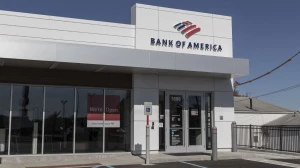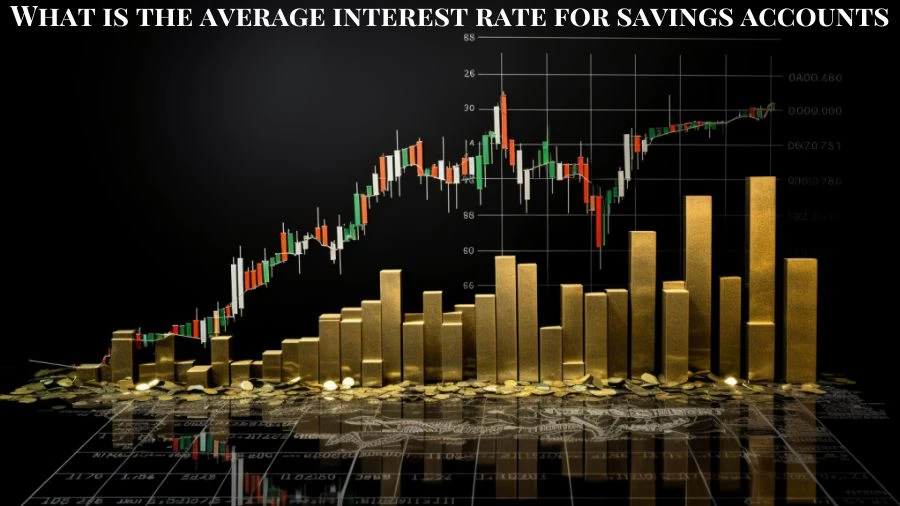
What is the Average Interest Rate for Savings Accounts? How to Calculate the Average Interest Rate for Savings Account?
The average interest rate for savings accounts in the United States is around 0.43% APY, with rates varying by bank and account type.
by Kowsalya
Published Sep 01, 2023 | Updated Sep 01, 2023 | 📖 10 min read
On This Page
- What is the Average Interest Rate for Savings Accounts?
- How to Calculate the Average Interest Rate for Savings Account?
- Can Interest Rates on Savings Accounts Change?
- What Could Be the Reasons Behind Fluctuations in Interest Rates for Savings Accounts?
- Is an Online Savings Account Better?
- Are There Any Other Types of Savings Products?
- How Can Increase the Saving Account Interest Rate?
What is the Average Interest Rate for Savings Accounts?
The average interest rate on savings accounts in the United States is currently 0.43% APY. This rate applies to both average and jumbo deposits, with jumbo deposits referring to accounts holding balances over $100,000.
After the Great Recession, savings account interest rates experienced a significant decline. In 2009, the national average rate for average savings deposits dropped to approximately 0.22%. This decline was largely influenced by the Federal Reserve's decision to lower rates in December 2008, maintaining these lower rates until 2015. Subsequent years saw fluctuations in rates, including four rate hikes in 2018 that boosted savings account APYs, followed by three rate cuts in 2019.
The COVID-19 pandemic in 2020 led to another substantial decrease in rates. Brick-and-mortar banks tend to offer the lowest interest rates on savings accounts. Many major banks provide rates close to 0.01% APY for their basic savings accounts. While some higher balance tires might offer slightly better rates, they rarely exceed 0.10% APY.
For individuals seeking higher interest rates, online banks present more attractive options. Online savings accounts generally offer significantly higher rates compared to traditional banks. These competitive rates are often available to customers regardless of their account balance. Notable online banks with appealing rates include Ally Bank, Marcus by Goldman Sachs, and Synchrony.
How to Calculate the Average Interest Rate for Savings Account?
You can determine the simple interest accrued in a savings account by multiplying the initial balance (principal) by the annual interest rate, expressed as a decimal, and the time the money remains in the account. It's important to note that the interest in a savings account represents earnings, not payments.
The formula for simple interest is: Interest = P * R * T
Where:
- P stands for the principal amount (initial balance).
- R represents the interest rate per year (as a decimal).
- T denotes the number of time periods (usually in years).
For instance, suppose you have a savings account with an initial balance of $10,000, earning an annual interest rate of 2%. In decimal form, the interest rate is 0.02. The calculation would be: Interest = $10,000 * 0.02 * 1 = $200.
It's worth noting that the interest rates on the most competitive savings accounts are higher than 4%, while others offer much lower rates. As an example, the average national savings rate is around 0.43%.
This formula is particularly useful for obtaining a rough estimate of the interest your savings could generate based on the principal amount. However, for a more accurate projection of interest earned over time, it's essential to consider the impact of compounding.
Can Interest Rates on Savings Accounts Change?
The interest rates provided for savings accounts can vary due to several factors, including geographical location, account balance, the structure of the bank, the type of savings account, and prevailing market conditions. Additionally, the rates banks and credit unions offer for deposits are influenced by the federal funds rate, established by the U.S. Federal Reserve.
This stands as a notable distinction between savings accounts and term deposits like Certificates of Deposit (CDs). When you invest in a CD, you secure the advertised interest rate for your chosen term, regardless of potential market changes. However, rates for savings accounts are not usually guaranteed to remain constant over time.
What Could Be the Reasons Behind Fluctuations in Interest Rates for Savings Accounts?
During periods of economic downturn, the Federal Reserve often employs a strategy of reducing interest rates to stimulate economic activity. By doing so, they aim to make borrowing and investing more appealing to the general population. The underlying principle is to incentivize increased spending, which in turn can help reinvigorate the sluggish economy. While this approach benefits those who wish to borrow funds, it can be less favorable for individuals focused on saving.
The impact of lowered interest rates on savers is noteworthy. Financial institutions typically tie their savings account yields to the federal funds rate, which serves as a benchmark. Consequently, when the central bank decides to lower interest rates, banks are inclined to decrease the interest offered on savings accounts as well. This creates a situation where savers might experience diminished returns on their savings compared to earlier periods.
Conversely, when the Federal Reserve opts for a policy of raising interest rates, it acts as a tool to curb excessive economic growth. Borrowing becomes costlier under such circumstances, leading to an environment that encourages saving. In response, banks tend to offer more attractive savings account yields, presenting savers with an opportunity to build and safeguard their financial resources for the future, all while maintaining their purchasing power.
It is prudent to emphasize the enduring value of maintaining a savings account, regardless of the prevailing economic conditions. A savings account serves as a reliable avenue for setting aside funds for various goals. However, it's crucial to recognize that the extent of the returns generated from a savings account hinges on the specific type of account one chooses.
Is an Online Savings Account Better?
When comparing online savings accounts to traditional brick-and-mortar options, it's clear that online banks often offer more appealing features and advantages. The national average savings account interest rate, despite a gradual increase, remains modest and is reflective of the lower rates offered by traditional banks.
These established banks commonly provide interest rates ranging from 0.01% to 1.4%. In contrast, online banks and emerging financial institutions present a different picture. They entice new customers with interest rates starting at 1% and potentially exceeding 3%.
The primary distinction lies in the types of savings accounts offered by these two categories of banks. Online banks are known for high-yield savings accounts and money market deposit accounts, while brick-and-mortar banks lean toward conventional savings accounts that typically yield lower interest rates. Though both account types offer comparable features and security, the difference in interest rates is substantial.
Online banks are attractive due to their ability to offer competitive yields on savings, requiring relatively modest minimum balances and often waiving maintenance fees. This combination of benefits positions online banks as formidable alternatives to traditional counterparts.
Their capability to provide higher yields can be attributed to cost advantages: operating primarily in the digital sphere enables online banks to avoid the overhead costs associated with physical branches. As a result, online savings accounts boast Annual Percentage Yields (APYs) that far surpass the average rates of conventional savings accounts.
Consider a high-yield savings account illustration: with an initial deposit of $10,000 and an interest rate of 1.5%, you could earn $150 in interest. This figure starkly contrasts with the interest earned using the national average APY. This highlights the importance of selecting a banking institution with a reasonable savings account interest rate.
Although online banks may appear as the clear choice due to their enticing rates, it's worth noting that several traditional banks, particularly those adopting hybrid models, are now entering the competition with competitive yields. Conducting thorough research and evaluating available options is crucial in making an informed decision about the ideal destination for your financial resources.
Are There Any Other Types of Savings Products?
Apart from exploring bank savings accounts and their yields, diversifying your research to consider various savings products can offer you satisfactory returns while maintaining low risk. Here are some alternative saving products to consider:
Money Market Accounts:
Money market accounts, or money market deposit accounts (MMDAs), closely resemble savings accounts. They are offered by banks and credit unions and often combine features of both savings and checking accounts, including debit cards and check-writing capabilities. In comparison to regular savings accounts, money market accounts generally offer higher interest rates.
For instance, as of July 2023, the national average MMDA interest rate stands at 0.63%, while the average savings rate is 0.42%. While the difference may appear small, as overall interest rates rise, the yield gap between these two account types can widen, making money market accounts more attractive.
However, it's essential to note that money market accounts come with limitations, such as restricted transactions, potential fee payments, and minimum balance requirements.
Certificates of Deposits (CDs):
Certificates of Deposits are savings products that earn interest on a fixed amount of money deposited over a predetermined period. They are offered by banks and credit unions and often provide some of the highest interest rates among savings products, surpassing savings and money market accounts. CDs require a commitment to a fixed term without withdrawals and may have minimum deposit requirements.
There are two main types of CDs: fixed-term CDs and no-penalty CDs. With a fixed-term CD, you agree to keep your deposit untouched until the maturity date, and there are penalties for early withdrawal. On the other hand, no-penalty CDs offer more flexibility in accessing your funds without incurring penalties.
Both types of CDs provide clarity about the exact return you'll receive at the end of the maturity period, ensuring predictability regardless of market fluctuations. This feature is particularly useful for individuals on fixed incomes or tight budgets, as they offer a guaranteed amount earned over a specific time frame.
How Can Increase the Saving Account Interest Rate?
Increasing the interest rate on a savings account can be a smart financial move to help your money grow over time. Here are some explaining how you can increase the interest rate on your savings account,
Choose the Right Type of Savings Account:
- Different types of savings accounts offer varying interest rates. To increase your savings account interest rate, start by choosing the right type of account. Look for high-yield savings accounts (HYSAs) or money market accounts, which typically offer higher interest rates than regular savings accounts.
- Compare interest rates offered by different banks and financial institutions. Online banks often provide more competitive rates than traditional brick-and-mortar banks, so consider opening an online savings account.
Maintain a Good Credit Score:
- Your credit score can indirectly affect the interest rate on your savings account. Banks may offer better rates to customers with a strong credit history because they are considered less risky.
- To improve your credit score, pay bills on time, reduce outstanding debt, and avoid opening too many new credit accounts. A higher credit score may lead to more favorable savings account offers.
Negotiate with Your Bank:
- Don't hesitate to negotiate with your current bank or credit union to secure a higher interest rate on your savings account. While interest rates are generally determined by the bank's policies, you can sometimes get a better deal by expressing your loyalty and discussing your options.
- Mention competitive rates offered by other banks and ask if your bank can match or improve upon those rates. Banks may be willing to negotiate, especially if they value your long-term relationship as a customer.
Consider Long-Term Savings Options:
- To achieve higher interest rates on your savings, consider long-term savings options like certificates of deposit (CDs). CDs typically offer fixed interest rates for a specific term, which can be higher than standard savings account rates.
- Evaluate the available CD terms and select one that aligns with your financial goals. Keep in mind that with CDs, your money will be locked in for the chosen term, so only use this option if you can afford to leave the funds untouched for that period.
What is the Average Interest Rate for Savings Accounts - FAQs
1. What is the Average Interest Rate for Savings Accounts?
The average interest rate for savings accounts in the United States is approximately 0.43% APY (Annual Percentage Yield).
2. Why are savings account interest rates relatively low?
Savings account interest rates tend to be low because they are influenced by factors such as the federal funds rate set by the U.S. Federal Reserve.
3. Do all banks offer the same interest rates on savings accounts?
No, not all banks offer the same interest rates on savings accounts.
4. How can I find a savings account with a higher interest rate?
To find a savings account with a higher interest rate, you can compare offers from various banks online.
5. Can I increase the interest rate on my savings account?
Yes, you can potentially increase the interest rate on your savings account by choosing a bank that offers a higher rate.




